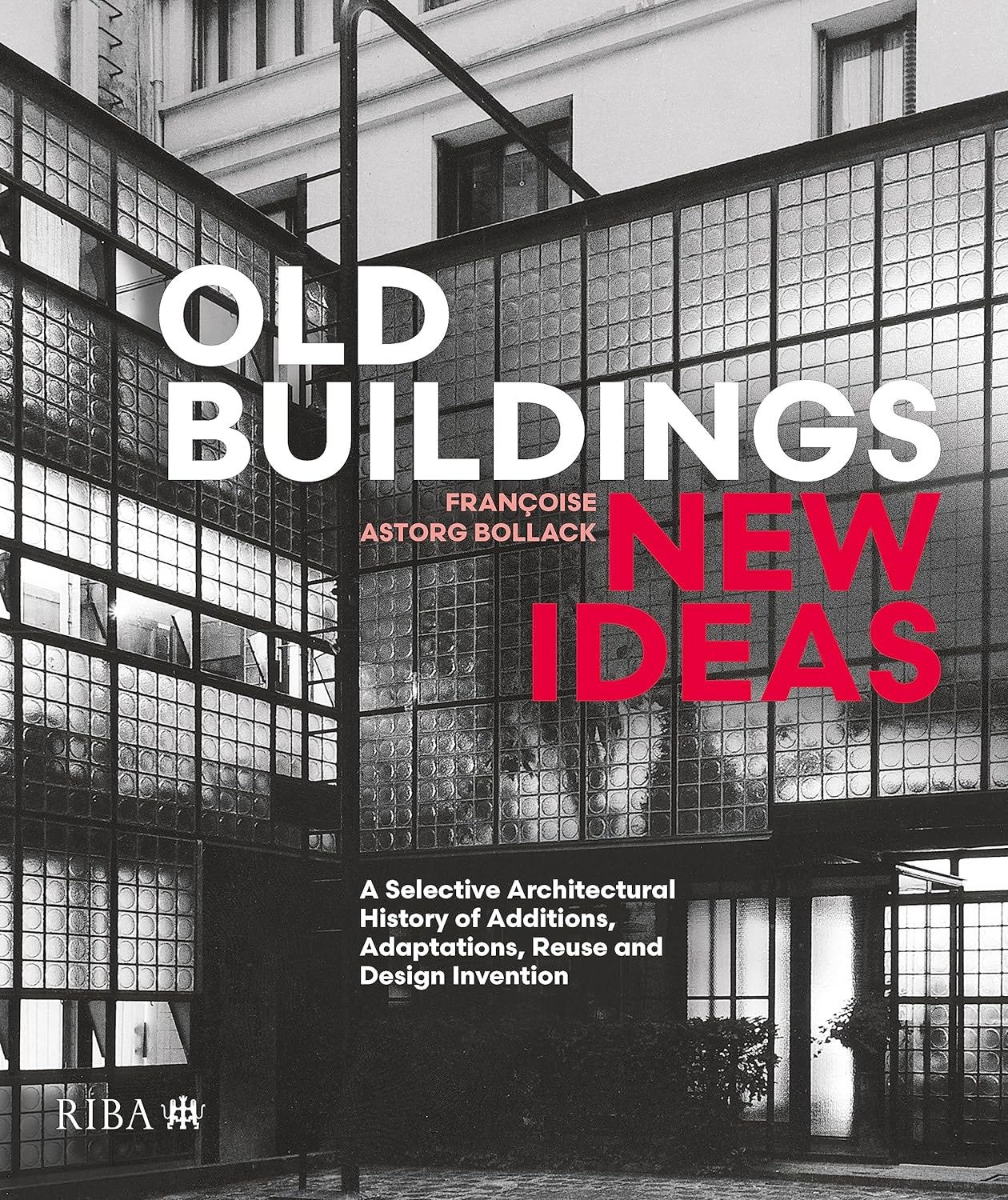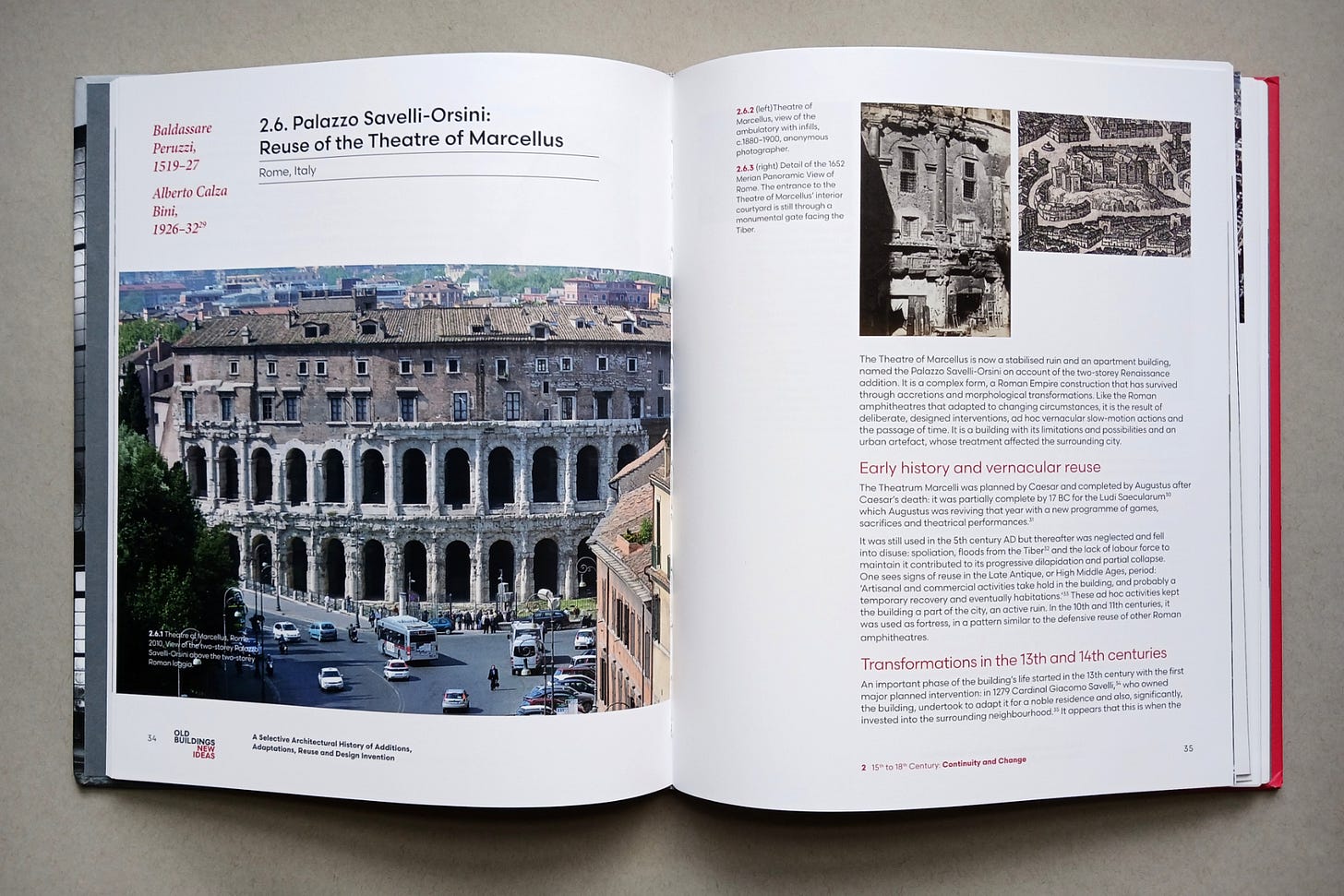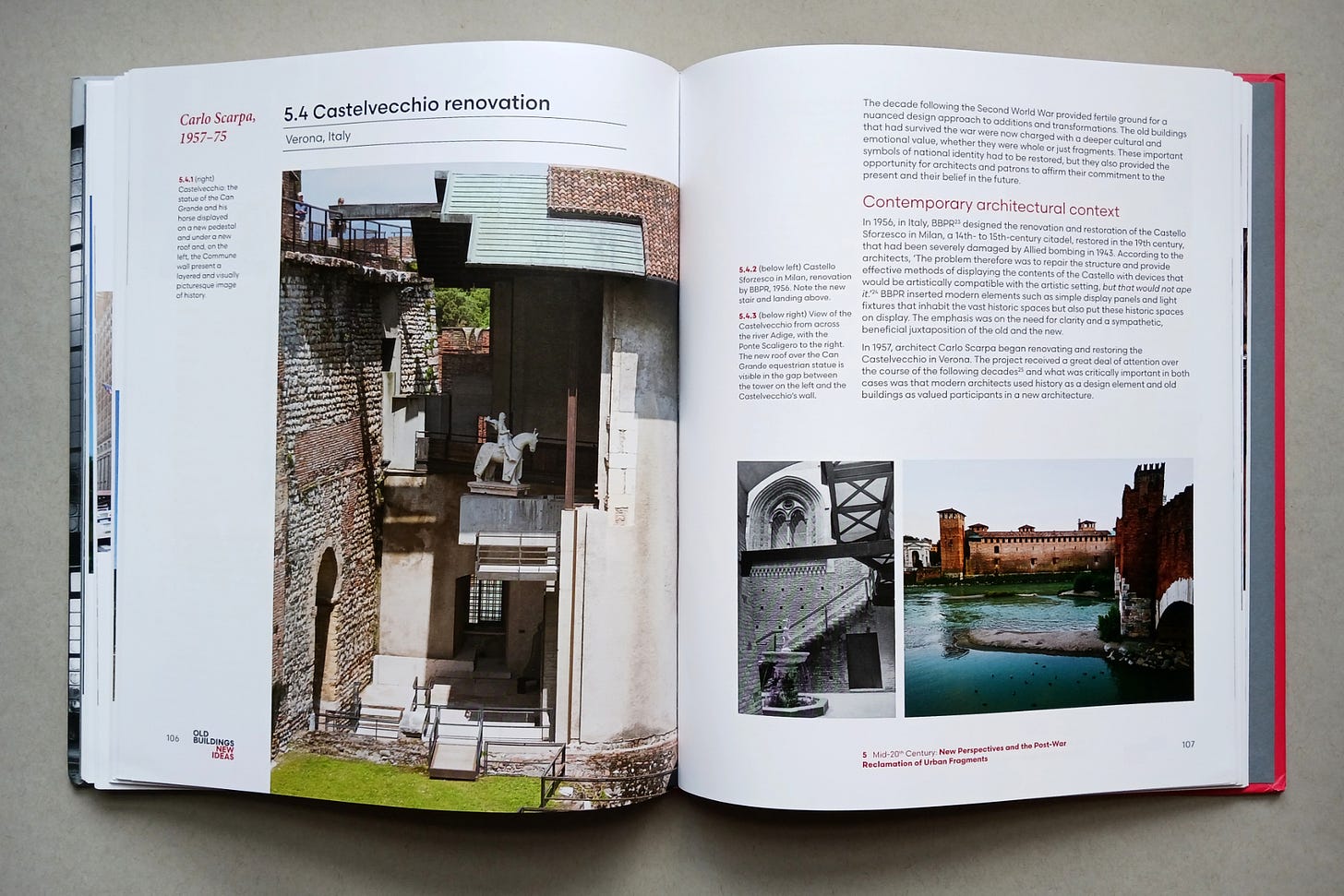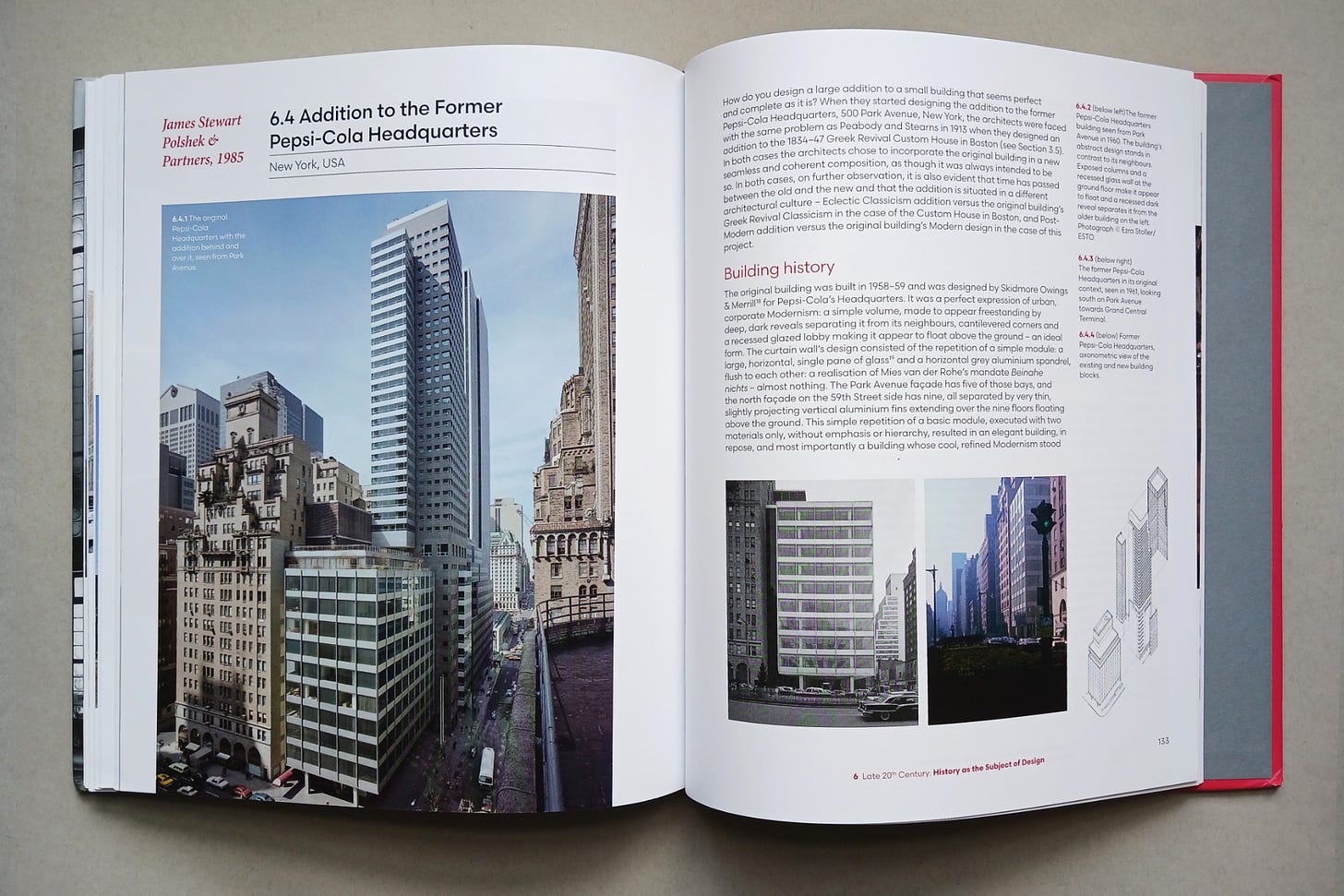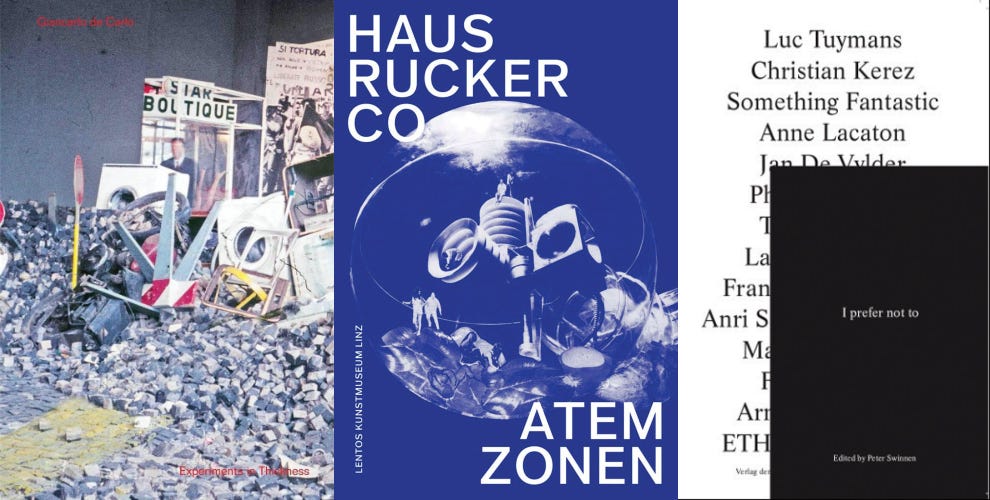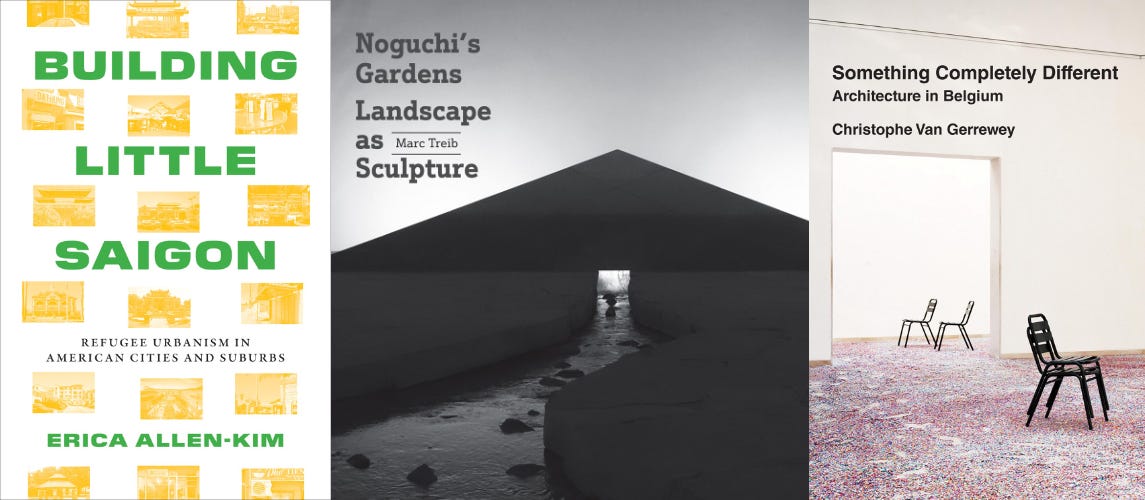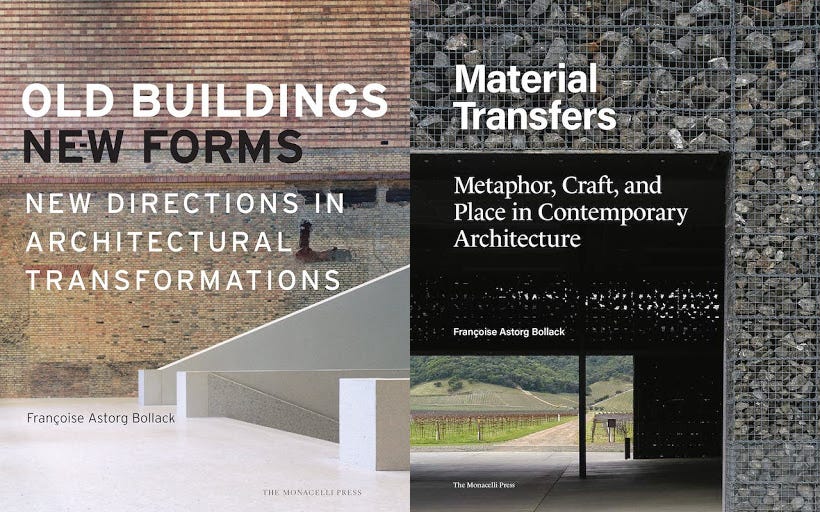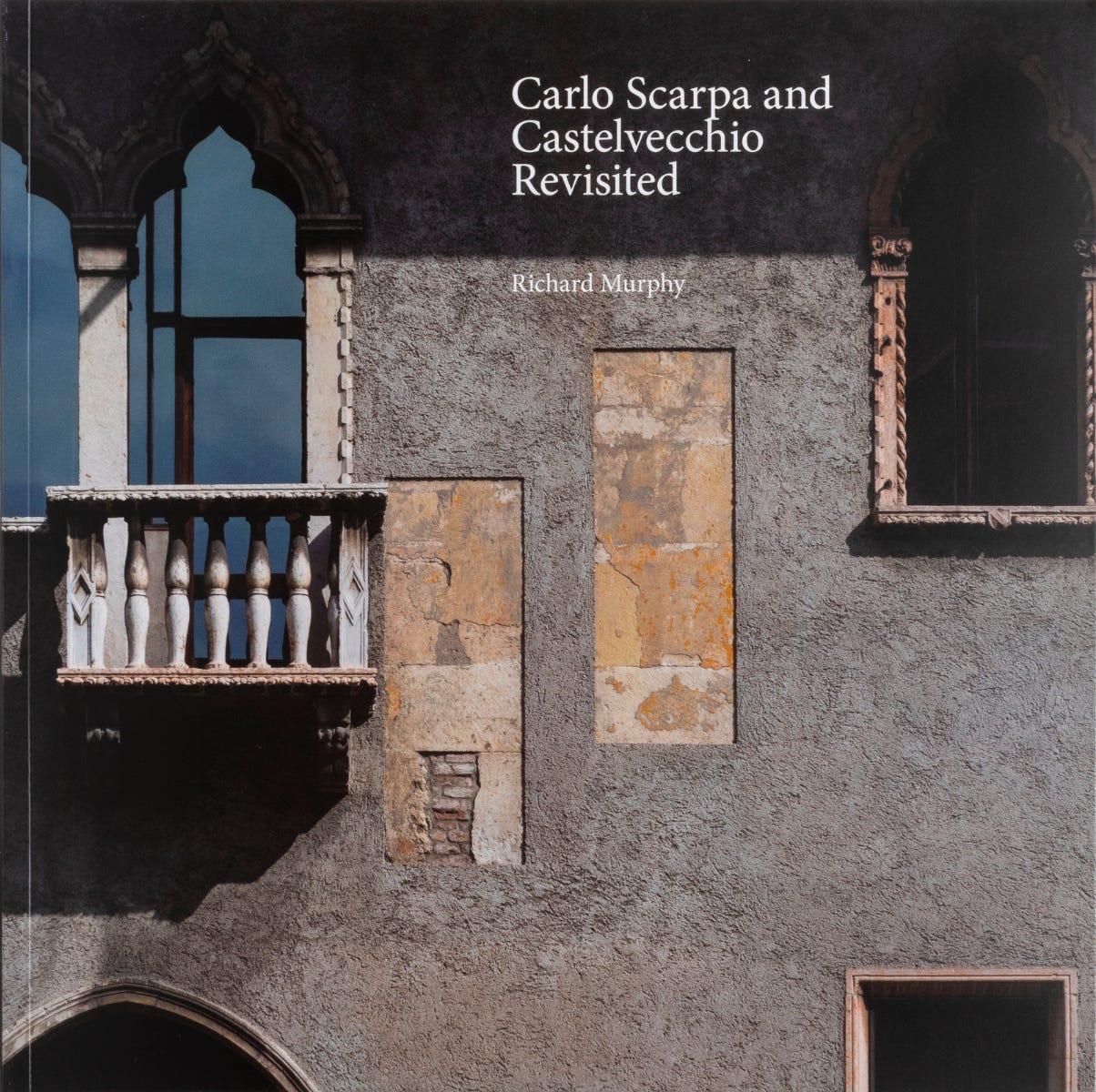This newsletter for the week of July 1 is going back in time, looking at books that survey new buildings in old settings. Françoise Astorg Bollack's Old Buildings, New Ideas is at top as Book of the Week, while a few related books from the archive are at the bottom. In between are the usual newly released architecture books and a few headlines.
🎆 Note: With the 4th of July holiday on Thursday, I’m taking the rest of this week off. The next newsletter will land in your inbox on July 15, aka week 29. 🎆
Book of the Week:
Old Buildings, New Ideas: A Selective Architectural History of Additions, Adaptations, Reuse and Design Invention by Françoise Astorg Bollack (Buy from RIBA Books / from Amazon / from Bookshop)
Recently the winner of the latest Steedman Fellowship in Architecture, given out every two years by Washington University in St. Louis since 1926, was announced. This news brought back my three (unsuccessful) attempts to win the traveling fellowship. Run as a design competition with a different jury and different site and program for each iteration, my designs were appropriately varied, as in a sloping “landscraper” for the banks of the Seine. Nevertheless, the intended subject of my travels, which had to be defined by entrants at the time of their submissions, generally stayed the same across all three competitions that I entered (the fellowship is limited to eight years after graduation): to study the interaction of old and new buildings in cities. Most likely my first submission, for the 1998 competition that is illustrated in the link above, was my attempt to see more of Europe than I could afford to do after spending a semester in Italy in architecture school. But as I practiced architecture and then wrote about architecture on my blog starting in 1999, my interests continued to veer toward how new buildings sit beside old buildings; how they are adaptively reused from old buildings; and how they keep history alive, if you will, for future generations. Based on Old Buildings, New Ideas, published last fall by RIBA Publishing, I reckon Françoise Astorg Bollack has very similar interests to mine.
Old Buildings, New Ideas is not the first book finding Bollack surveying buildings with an emphasis on interactions between new and old (a couple earlier ones are at the bottom of this newsletter), but it is the first to hit shelves at a time when the wider architectural culture is focused on conservation, restoration, renovation, adaptive reuse, and other means of retaining part or all of existing buildings to help combat the carbon emissions that come with the construction of new buildings. As such, Bollack’s decades-long push for preservation and transformation over new construction is finding increased relevance today. “We talk about embodied material and cultural energy,” she writes in the book’s introduction, “and we are developing a culture of continued use and reuse.” Even though Bollack clarifies that this is happening due to “the real threat of extinction posed by the climate crisis,” she sees it in formal terms: “At last, now, the value of existing buildings is well recognized and becomes part of the design process — an opportunity to be seized creatively.” So this is not a book to belabor the sustainable benefits of adaptive reuse or provide technical solutions for conservation and transformation. Rather, it offers inspiration for architects working on such projects, by providing numerous examples across history and framing them in terms of general approaches of new interacting with old.
Bollack presents nearly thirty projects in six chronological chapters, moving from Roman ruins to the Renaissance, the 19th century and, across half of the book’s chapters, the 20th century. A few examples are illustrated here: Palazzo Savelli-Orsini, an apartment building inside a stabilized Roman ruin, the Theatre of Marcellus; Carlo Scarpa’s famed transformation of the Castelvecchio in Verona into a museum (see also the bottom of this newsletter); and James Stewart Polshek’s addition to Pepsi’s old SOM-designed headquarters on Park Avenue (an addition I’m ashamed to have not been familiar with, regardless of liking SOM’s mid-century glass box). These projects fall into three of Bollack’s five typological categories for adding new elements to old fabric, as described in the appendix: Insertions (Palazzo Savelli-Orsini), Weavings (Castelvecchio), and Parasites (Pepsi-Cola); the other two are Wraps and Juxtapositions. It is easy to see from these names how Bollack focuses on formal aspects of design: basically how new elements (walls, floors, roofs, and their openings) relate to the same elements in old buildings. But why not use these categories to serve as the book’s chapters, eschewing a historical timeline in favor of the formal approaches so prized by Bollack? One answer is found in the lopsidedness of the categories, with just one Wrap, two Juxtapositions, and nearly as many Insertions as Parasites and Weavings combined. But mainly, the chronological structure allows Bollack to touch on the changes in architectural transformations over many centuries and across the 20th century, a commendable aspect of the book.
What is the value, ultimately, of Old Buildings, New Ideas? Architectural surveys have traditionally served as inspiration for architects and architecture students, allowing them to see and understand precedents on paper they might not be able to experience in person. But, for better or worse, the internet has basically supplanted books like these in that role, especially with students, who probably use YouTube and TikTok more than the the words and images found in books or on the internet to learn about buildings. I’d wager that the value of Bollack’s book lies in the fact that all of the old buildings and pieces of urban fabric surveyed in the book still exist — cut up, added to, and transformed in other ways, they were all retained rather than demolished. As I wrote above, this book arrives as the wider architectural culture embraces preservation and adaptive reuse for limiting carbon emissions, but society at large continues to demolish at an alarming rate, with owners letting old buildings decay without proper maintenance and then using the high cost of rehabilitation as a reason for demolition (or they carry out LEED Platinum interior renovations on the old building but then demolish it anyways). Hopefully, Old Buildings, New Ideas convinces people — the right people — that keeping buildings is always preferable to demolishing them, and that the most interesting places combine old and new in creative ways. And really, who wouldn’t want a city full of Parasites?
Books Released This Week:
(In the United States, a curated list)
Giancarlo de Carlo: Experiments in Thickness edited by Kersten Geers and Jelena Pancevac (Buy from Walther König/DAP / from Amazon / from Bookshop) — The first of a trio of books coming out this week from German publisher Walther König is the expansive photo documentation of the eight buildings Giancarlo de Carlo’s in Urbino, most of them part of the Collegio del Colle. The book is part of the “Everything without Content” series by Kersten Geers, Jelena Pancevac and Joris Kritis.
Haus-Rucker-Co: Atemzonen edited by Hemma Schmutz (Buy from Walther König/DAP / from Amazon / from Bookshop) — This book, published with Lentos Kunstmuseum Linz, presents the utopian architecture of Haus-Rucker-Co as two books in one: one part of the book opens horizontally while the other opens vertically.
I Prefer Not To.... edited by Peter Swinnen (Buy from Walther König/DAP / from Amazon / from Bookshop) — A “free associative recount” of the I Prefer Not To lecture series that was staged at ETH Zurich in 2016/17. Of course, Anne Lacaton is there (see Place Léon Aucoc), but so are Christian Kerez, Jan De Vylder, Arno Brandlhuber, and numerous others who spoke about professional abstinence.
Building Little Saigon: Refugee Urbanism in American Cities and Suburbs by Erica Allen-Kim (Buy from University of Texas Press / from Amazon / from Bookshop) — An in-depth look at nearly fifty years of city building by Vietnamese Americans in American communities known as “Little Saigons.”
Noguchi's Gardens: Landscape as Sculpture by Marc Treib (Buy from ORO Editions / from Amazon / from Bookshop) — Marc Treib, who has written a book about Isamu Noguchi before, delves deeply into the landscape designs of Noguchi, “from his early unrealized projects for playgrounds and monuments to a large park in Sapporo, Japan, whose construction was completed only posthumously.”
Something Completely Different: Architecture in Belgium by Christophe Van Gerrewey (Buy from The MIT Press / from Amazon / from Bookshop) — Billed as “a kind of anti-guidebook,” the seven essays in this book use the nearly 200-year-old country of Belgium as “a case study to describe, interpret, and criticize more universal spatial problems and behaviors.”
Full disclosure: As an Amazon Associate, AbeBooks Affiliate, and Bookshop.org Affiliate, I earn commissions from qualifying purchases made via any relevant links above and below.
Book News:
Over at World-Architects, I give a visual tour through Carlo Scarpa: The Complete Buildings, a new book from Prestel featuring photographs by Cemal Emden that comes out next week. I’ll have a more in-depth review of the book in this newsletter in two weeks.
The MIT Press Reader puts online an excerpt from the facsimile edition of Learning from Las Vegas (The MIT Press, 1972/2017), in which Denise Scott Brown “looks back on the creation of the book and explains her and Robert Venturi’s reservations about the original design” by Muriel Cooper.
Texas Standard features an interview with author Kathryn E. O’Rourke and photographer Ben Koush about their new book, Home, Heat, Money, God: Texas and Modern Architecture. (University of Texas Press, 2024).
Elizabeth Farrelly reviews — and tepidly recommends — Richard Weller’s To the Ends of the Earth: A Grand Tour for the 21st Century (Birkhäuser, 2024), which was released in the US back in February.
In “A Refugee Camp is a Complex Web of History, Architecture, and Politics” at Columbia News, Eve Glasberg talks with Anooradha Iyer Siddiqi about her new book, Architecture of Migration (Duke University Press, 2023), which “asks readers to reconsider the Dadaab refugee camps in Africa through a new lens.”
From the Archives:
This week’s Book of the Week is not my first encounter with the books of Françoise Astort Bollack. I reviewed two of her books on my blog and draw your attention to them here. Back in 2013 I wrote that Old Buildings, New Forms: New Directions in Architectural Transformations (Monacelli, 2013) “Bollack presents historical precedents that lend credence to the handful of techniques she highlights [Insertions, Parasites, Wraps, Juxtapositions, and Weavings], while also adding weight to the idea that transformations are necessary and welcoming.” Later, in 2021, I wrote that, compared to Old Buildings, New Forms, Material Transfers: Metaphor, Craft, and Place in Contemporary Architecture (Monacelli, 2020) “is open to more expansive approaches of contemporary architecture interacting with historic buildings,” with such buildings as MVRDV’s Glass Farm — new construction and technology with a historical, zoning-mandated form — alongside the same Dutch firm’s Crystal Houses, a replica facade made of traditional terracotta bricks dissolving into solid glass bricks at street level.
Any book that bills itself as “A Selective Architectural History of Additions, Adaptations, Reuse and Design Invention,” as this week’s Book of the Week does, needs to include Castelvecchio, Carlo Scarpa’s masterpiece in Verona. Scarpa’s transformation of a military fort into a museum over the course of three decades is exhaustively documented by UK architect Richard Murphy in Carlo Scarpa and Castelvecchio Revisited, which he self-published in 2017, more than 25 years after Butterworth published his now hard-to-find Carlo Scarpa & Castelvecchio. I included the expanded book in Buildings in Print: 100 Influential & Inspiring Illustrated Architecture Books, saying it “must be the most detailed building monograph ever put to paper.” The book features more than two thousand illustrations: photographs, drawings by Murphy and his students from the 1980s onwards, and sketches by Scarpa that have been carefully preserved by the museum. With so many illustrations, the design of the book is particularly important — and successful, with the juxtapositions of photos and drawings/sketches allowing the reader to greatly understand Scarpa’s masterful “Weaving.”
Thank you for subscribing to A Weekly Dose of Architecture Books. If you have any comments or questions, or if you have your own book that you want to see in this newsletter, please respond to this email, or comment below if you’re reading this online. All content is freely available, but paid subscriptions that enable this newsletter to continue are welcome — thank you!
— John Hill




